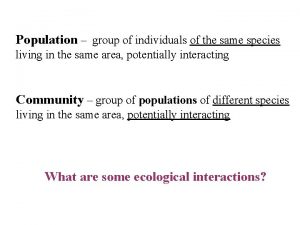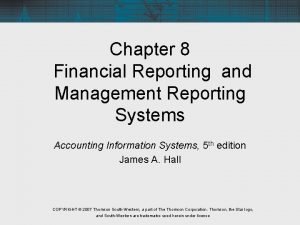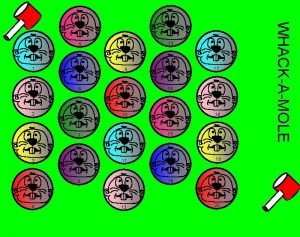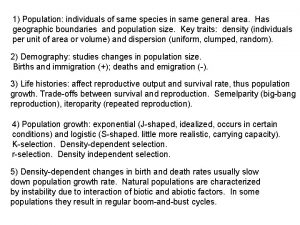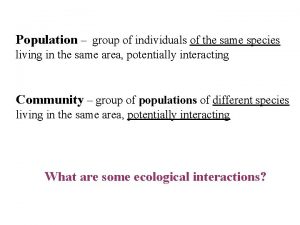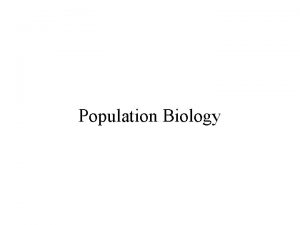Population individuals of same species in same general







- Slides: 7

- Population: individuals of same species in same general area. Has geographic boundaries and population size. Key traits: density (individuals per unit of area or volume) and dispersion (uniform, clumped, random). - Demography: studies changes in population size. Births and immigration (+); deaths and emigration (-). - Life histories: affect reproductive output and survival rate, thus population growth. Trade-offs between survival and reproduction. Semelparity (big-bang reproduction), iteroparity (repeated reproduction). - Population growth: exponential (J-shaped, idealized, occurs in certain conditions) and logistic (S-shaped. little more realistic, carrying capacity). K-selection. Density-dependent selection. r-selection. Density independent selection. - Density-dependent changes in birth and death rates usually slow down population growth rate. Natural populations are characterized by instability due to interaction of biotic and abiotic factors. In some populations they result in regular boom-and-bust cycles. -Human population growth, age pyramids, ecological footprint. CHAPTER 52: pages 1151 -1153, 1156 -1171

Study Guide 1 - Understand all the concepts in the guide, do not memorize the examples. 2 - Read the pages in the book to look at other examples and further understand the concepts. 3 - Study the answers to questions written by students and discussed in class

Community. All the organisms of all the species inhabiting an area. Plant communities apparently determined by chance occurrence of species with similar requirements. Unclear in animal communities. The properties and structure of a community are defined by its species composition and the interactions between the species. Interspecific Interactions Competition: -/Predation (includes herbivory and parasitism): +/Mutualism: +/+ (obligatory or facultative= facilitation) Commensalism: +/0 Key in shaping communities: competition, predation and mutualism. Species interactions involved in determining trophic structure, dominant and keystone species, and community control. All affect community structure. Trophic structure. Feeding relationships between organisms. Food chain, trophic levels and food web. Food webs have few trophic levels: energetic and dynamic stability hypotheses.

Dominant species. Control in community due to abundance. Keystone species. Control in community due to ecological role. Community organization. Bottom-up model. Changes in community structure controlled by bottom trophic levels (competition and available food). Top-down model. Changes in community structure controlled by upper trophic levels (predation). Communities are dynamic, constantly changing, due to disturbance. Humans are the greatest agents of disturbance. Ecological succession- Transitions in species composition over ecological time. Primary succession- It begins in a virtually lifeless area where soil has yet not formed. Secondary succession- Occurs where an existing community has been cleared by some disturbance that leaves the soil intact. CHAPTER 53: pages 1174 -1191

Ecosystem. All the organisms living in a community AND the abiotic factors with which they interact. Ecosystem Dynamics 1 - Energy flow Primary production gross and net aquatic (light and nutrients). terrestrial (climate and nutrients). Secondary production gross and net production and trophic efficiencies biomass and number pyramids green world hypothesis. 2 - Matter (chemical) cycling Biogeochemical model. Water, carbon, nitrogen. Role of decomposers. Vegetation regulation. CHAPTER 54: pages 1198 -1214

What is conservation biology? Levels of biological diversity (biodiversity). genetic, species, ecosystem diversity. Why preserve biodiversity? Where preserve biodiversity? Terrestrial and marine biodiversity hotspots. Biodiversity loss and poverty are linked problems. How to preserve biodiversity? What are the major threats to biodiversity? Habitat destruction and fragmentation: farming. Introduced species. Overexploitation. Other human impacts: climate change CHAPTER 55: pages 1224 -1229

- Is a forest or grassland considered a uniform distribution? - When calculating population sizes, do you count migratory species? - Do we know the carrying capacity of the world for humans? - When determining human population growth, do the only consider natural death or all causes? - In the barnacle example, are you saying that Balanus is better suited to the environment and that if desiccation was not a problem at the higher water level, they would force out the Chthamalus? - Assuming two species occupy the same ecological niche, why couldn’t they both co-exist assuming they were equally fit? - Wouldn’t ash and other material be nutrient-rich and counted as soil, therefore making it secondary succession? - What happens to the rest of the light energy if only 1% is used? - How would omnivores be classified in consumer nomenclature? - If organic and inorganic materials are only recycled, where are they from? - Is there any way to artificially produce photosynthesis to limit CO 2? - If we need 2, 000 calories per day and maybe half go out as feces, does that mean that we use only 10 calories for growth per day?
 What is a group of individuals of the same species
What is a group of individuals of the same species Keystone species in desert
Keystone species in desert Management reporting systems
Management reporting systems Exponential growth would be represented by a ____ curve
Exponential growth would be represented by a ____ curve Chapter 4 section 1 population dynamics study guide
Chapter 4 section 1 population dynamics study guide Section 1 population dynamics
Section 1 population dynamics Population ecology section 1 population dynamics
Population ecology section 1 population dynamics Chapter 4 population ecology answer key
Chapter 4 population ecology answer key
